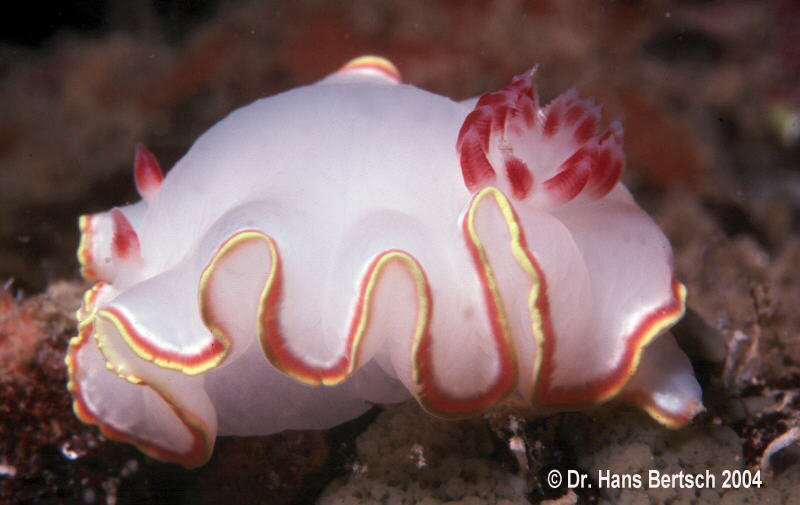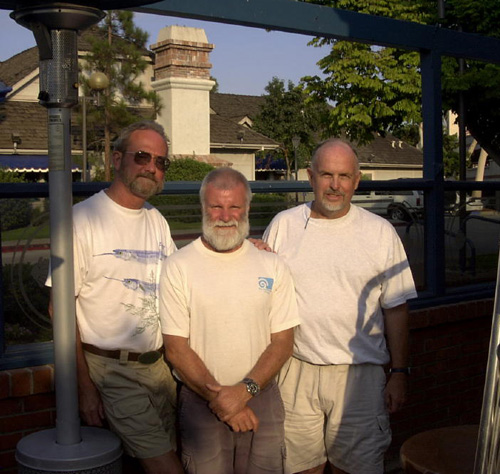 |
Glossodoris sedna
Photo courtesy of Dr. Hans BertschGlossodoris sedna (Marcus & Marcus, 1967)
This is the second time I have written a BOW (Nudibranch of the Week) about Glossodoris sedna. Some of the new pictures include "tub-shots" taken by me 30 years ago (see and click onto: Glossodoris sedna copulating pair , and Glossodoris sedna with egg mass . Although these photographs are not of the greatest quality, they both show important aspects of this species’ reproductive biology.
Glossodoris sedna has had a saltational taxonomic placement. Marcus and Marcus (in American Opisthobranch Mollusks, Univ. of Miami, Stud. Tropical Oceanography, No. 6: 178-181, published 22 December 1967) named the species in the genus Casella.
James Lance, in Trans. San Diego Soc. Natural History 15 (2): 3-13, published 8 January 1968, named the species Chromodoris fayae in honor of our dear friend Faye Howard, a marvelous lady who studied whales and invertebrates in the Sea of Cortes, having often been stuck hundreds of meter from shore in the northern Gulf regions when the tide came slipping (too rapidly) back into shore! Her swimming skills were legendary, carrying collecting bucket and weighted down by collecting boots. Sadly, this species name fell as a junior synonym to Glossodoris sedna because of the laws of priority. It was published two weeks after the Marcus & Marcus species name.
In 1970, I placed this species in the genus Chromodoris. Later, because of the unknown radular anatomy of the type species of Glossodoris, and because of the distinctive elongate radular structure with many tooth rows and a "smaller" number of lateral teeth (especially in comparison with other chromodorids—a distinction which still holds up!), I erected the genus Chromolaichma to include C. sedna (as type species), C. dalli, C. punctilucens, and C. youngbleuthi.
Rudman (1983 and 1984) found and examined the holotype of Glossodoris (the nearly obscure xantholeuca), concluding that the genera Doriprismatica, Casella, and Chromolaichma are all synonyms of the older genus. He also examined (Rudman, 1986) various Indo-Pacific species of Glossodoris, carefully delineating synonyms (e.g., Chromodoris youngbleuthi = Casella rufomarginata = Glossodoris rufomarginata). Characteristic to all species in this genus (as Bertsch originally stated) is the extremely elongate radula, especially in relationship to the much smaller number of lateral teeth per half row.
Bertsch (1976, 1977, 1978 a, 1978 b, 1978 c) emphasized the use of radular meristics and morphology in generic and specific determinations. These significantly different features can often out-weigh other considerations that are based on a simplistic computer-generated comparison of lots of (often unimportant) features in determining a correct phylogeny.
Well, moving right along, into less controversial areas, attached to this BOW are SEMs of the radula, some of which have been published (Bertsch, 1978 a). The numbering of illustrations (figures and plates) determined the sequence of publication in my 4 articles; hence the SEMs of the radula of Glossodoris sedna is in Bertsch (1978 a), not in the article (Bertsch, 1978 b) which actually discussed G. sedna and presented line drawings and meristic tabulations of the radula.
The first figure shows an overview of the radula . The innermost lateral teeth on each side of the rachidian have the typical chromodorid strong, short cusps with accessory denticles. Midlateral teeth increase in length , with small accessory denticles on the outer side. The extremely outermost lateral teeth are shortened, smooth, and bluntly rounded.
The radular formula of over fifty specimens ranged from 66-131 (28-70.1.28-70) teeth rows and lateral teeth per column. The mean was 90 (40.1.40). Such an elongate radular ribbon with a high number of rows relative to the number of lateral teeth is characteristic of species within the genus Glossodoris. As predicted (Bertsch, 1976), similar to other sponge-feeding dorids, in animals within the species G. sedna, the maximum number of teeth per half row increases with the greater number of tooth rows, the number of tooth rows increases with the greater length of the radula, the radular width and maximum number of teeth per half-row are positively correlated, and the number of smooth outermost lateral teeth is also positively correlated with the size of the radula (Bertsch, 1978 b: 73).
Please note the typographic error in my 1978 b paper. In Table 8 (page 72), the extreme right-hand side column should be titled: "Maximum number of smooth, outermost teeth per half-row." These teeth range from 0-39, with a mean of 11.98. (I am still waiting to see 0.98ths of a tooth; sort of like the average number of children per couple is 2.3—have you seen the 0.3 child?)
ETYMOLOGY
Now for a whole different aspect of this species. Marcus and Marcus named numerous species, often without giving the etymology or derivation of the species name. I personally do not like that practice, and consider it a disservice to taxonomy and our understanding of the animals and the researchers! The naming of a species can involve important personal, historical, cultural, or geographic significance that should be stated. For instance, some species I have named (Mexichromis antonii, Mexichromis amalguae, Bornella sarape, and Phidiana lascrucensis) are in honor of my dear friend, mentor and colleague Antonio Ferriera; the original Cochimi native nation name for an island off the Pacific coast of the Baja California peninsula; a traditional blanket worn by people in Mexican villages, countrysides and hill regions; and the type locality of Las Cruces, near La Paz, Baja California Sur. These were all clearly stated in my publications. Various authors in the past have not clearly explained their specific name designations.
Marcus and Marcus never explained the origin of the name sedna. Here are some other examples of species named by either or both of the Marcuses, with my conjectures on the origin of these names.
Crimora conejo: probably from the Spanish word conejo that means rabbit. The significance escapes me, because there is really no resemblance.
Geitodoris mavis: maybe named after the song thrush (see the dictionary for this one).
Discodoris phoca: named after the genus of harbor seal (Phoca vitulina).
Sclerodoris tanya: named after Gale Sphon’s cat (whom I once met).
Chromodoris nyalya: possibly a misspelling of nyala, an artiodactylid bovid (belonging to the family that includes antelope, cattle, bison, buffalo, sheep, and goats). There are several species within the genus Tragelaphus: the mountain nyala and the nyala (T. buxtoni and T. angasi, respectively). Also within this genus are the greater and lesser kudus.
Which brings us now to
Glossodoris sedna
This is one of those incredible scientific juxtapositions that make doing science such an exciting multidisciplinary activity. A recent discovery in outer space (along with astronomical references) provide us with the much needed information about the origin of the Marcuses’ specific epithet.
In mid-March, scientists announced the discovery of a "frozen, shiny red world some 8 billion miles from Earth that is the most distant known object in the solar system." They hedged their bet and called it a planetoid (not a planet). Astronomers named it Sedna (officially 2003 VB 12). It is 800 to 1,100 miles in diameter, and is most likely half rock and half ice. It is the largest object found orbiting the sun since Pluto’s discovery by Clyde Tombaugh in 1930. This cold, distant object has a highly elliptical orbit, and it takes about 10,500 years to circle the sun. It can be as far as 84 billion miles from the sun, where the sun would look smaller than a pin head. It is unknown how it came to its erratic orbit: Pluto’s orbit averages 39 times the Earth-Sun distance (1 AU), whereas Sedna roams from 76 to 1,000 times the Earth-Sun distance! Even at its closest to the sun, the temperature on Sedna never gets above minus 400 degree Fahrenheit. And as our Indo-Pacific-diving webmaster Mike Miller would attest, that is below wet suit comfort!
True to the service quality of Yahoo! the internet sites where the news articles appeared are no longer available.
Now, to the moment you have been awaiting: the meaning of SEDNA: Sedna is an Inuit goddess who created the sea creatures of the Arctic. What a great name, and I regret that the Marcuses did not tell us that when they named this beautiful animal.
References:
Bertsch, Hans. 1970. Opisthobranchs from Isla San Francisco, Gulf of California, with the description of a new species. Contrib. Sci., Santa Barbara Mus. Nat. Hist.2: 1-16.
-----. 1976. Intraspecific and ontogenetic radular variation in opisthobranch systematics (Mollusca: Gastropoda). Systematic Zoology 25 (2): 117-122.
-----. 1977. The Chromodoridinae nudibranchs from the Pacific coast of America. Part I. Investigative methods, and supra-specific taxonomy. The Veliger 20 (2): 107-118.
-----. 1978 a. The Chromodoridinae nudibranchs from the Pacific coast of America. Part II. The genus Chromodoris. The Veliger 20 (4): 307-327.
-----. 1978 b. The Chromodoridinae nudibranchs from the Pacific coast of America. Part III. The genera Chromolaichma and Mexichromis. The Veliger 21 (1): 70-86.
-----. 1978 c. The Chromodoridinae nudibranchs from the Pacific coast of America. Part IV. The genus Hypselodoris. The Veliger 21 (2): 236-250.
Rudman, W. B. 1983. Glossodoris Ehrenberg, 1831, Hypselodoris Stimpson, 1855 and Chromodoris Alder & Hancock, 1855 (Gostropoda, Opisthobranchia): Proposed clarification and conservation. Z.N. (S.) 2432. Bulletin of Zoological Nomenclature 40 (4): 211-220.
Rudman, W. B. 1984. The Chromodorididae (Opisthobranchia: Mollusca) of the Indo-West Pacific: a review of the genera. Zoological Journal of the Linnean Society 81 (2/3): 115-273.
Rudman, W. B. 1986. The Chromodorididae (Opisthobranchia: Mollusca) of the Indo-West Pacific: The genus Glossodoris Ehrenberg (= Casella, H. & A. Adams). Zoological Journal of the Linnean Society 86: 101-184.
Imperial Beach, California
June, 2004
Hans Bertsch, Richard Willan, and Webmaster, Mike Miller
Chula Vista, Calif, Aug. 2002

192 Imperial Beach Blvd. #A Imperial Beach, CA 91932 Send Hans E-Mail at hansmarvida@sbcglobal.net |
